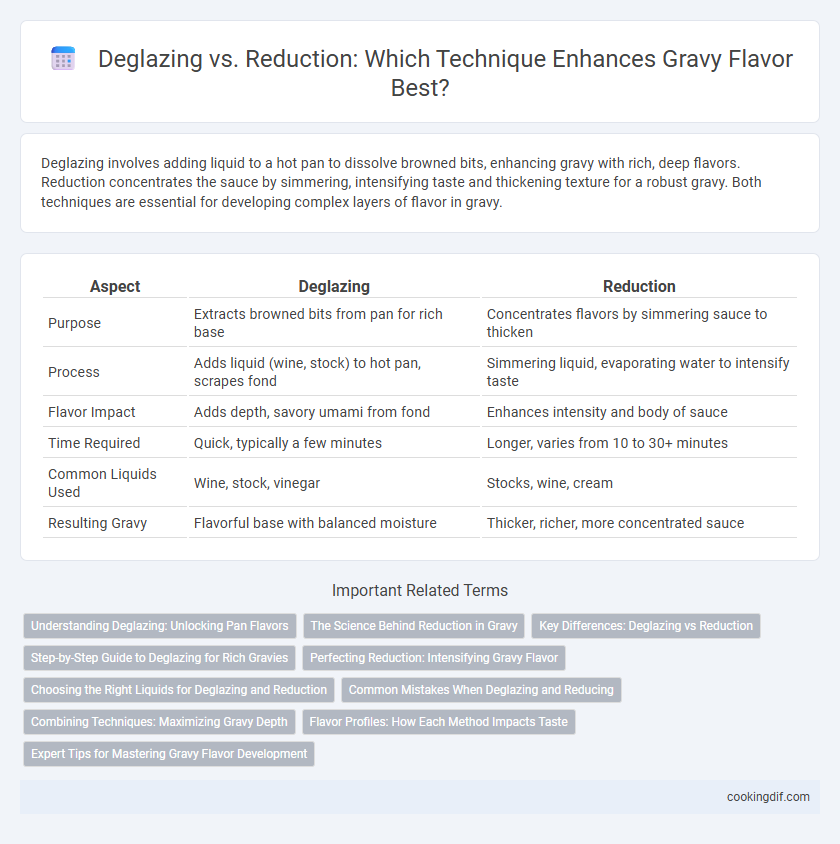Deglazing involves adding liquid to a hot pan to dissolve browned bits, enhancing gravy with rich, deep flavors. Reduction concentrates the sauce by simmering, intensifying taste and thickening texture for a robust gravy. Both techniques are essential for developing complex layers of flavor in gravy.
Table of Comparison
| Aspect | Deglazing | Reduction |
|---|---|---|
| Purpose | Extracts browned bits from pan for rich base | Concentrates flavors by simmering sauce to thicken |
| Process | Adds liquid (wine, stock) to hot pan, scrapes fond | Simmering liquid, evaporating water to intensify taste |
| Flavor Impact | Adds depth, savory umami from fond | Enhances intensity and body of sauce |
| Time Required | Quick, typically a few minutes | Longer, varies from 10 to 30+ minutes |
| Common Liquids Used | Wine, stock, vinegar | Stocks, wine, cream |
| Resulting Gravy | Flavorful base with balanced moisture | Thicker, richer, more concentrated sauce |
Understanding Deglazing: Unlocking Pan Flavors
Deglazing involves adding liquid, such as wine or broth, to a hot pan to dissolve browned bits called fond, which are rich in concentrated flavors essential for gravy. This technique unlocks deep, complex tastes by capturing caramelized residues from searing meats, enhancing the overall flavor profile. Proper deglazing sets the foundation before reduction, which intensifies and thickens the liquid to create a richly flavored, velvety gravy.
The Science Behind Reduction in Gravy
Reduction intensifies gravy flavor by evaporating water, concentrating natural sugars, amino acids, and other flavor compounds through heat. This process triggers Maillard reactions, enhancing savory and caramelized notes essential to deep, rich gravy profiles. Understanding reduction science enables precise control over texture and taste, creating a balanced and robust gravy consistency.
Key Differences: Deglazing vs Reduction
Deglazing involves adding liquid to a hot pan to dissolve browned food residue, capturing intense, concentrated flavors essential for a rich gravy base. Reduction refers to simmering the liquid to evaporate water, intensifying flavors and thickening the gravy for a robust, velvety texture. Both techniques enhance flavor development in gravy but differ in timing and purpose--deglazing resets the skillet's flavor foundation, while reduction focuses on concentrating and enriching the sauce.
Step-by-Step Guide to Deglazing for Rich Gravies
Deglazing involves pouring a liquid such as wine, broth, or vinegar into a hot pan after searing meat to dissolve browned bits and infuse gravies with concentrated flavors. The process begins by removing excess fat, then adding the liquid while scraping the pan to release fond, which contains savory compounds essential for rich texture and depth. Reducing the liquid afterward thickens the gravy, enhancing the intensity of taste and creating a smooth, velvety finish perfect for elevating meat dishes.
Perfecting Reduction: Intensifying Gravy Flavor
Perfecting reduction intensifies gravy flavor by simmering the liquid to concentrate natural juices and caramelized bits, enhancing depth and richness. Deglazing adds initial flavor by dissolving browned residues from the pan using liquids like wine or stock. Mastering reduction transforms these flavors into a thicker, more robust gravy with a balanced, savory profile.
Choosing the Right Liquids for Deglazing and Reduction
Selecting the ideal liquids for deglazing and reduction significantly enhances gravy's flavor profile by extracting and concentrating savory compounds from the pan. Wine, stock, or vinegar are preferred for deglazing due to their acidic properties that dissolve browned bits, while concentrated broths and reduced juices intensify richness in reductions. Balancing acidity and concentration in chosen liquids ensures a complex, robust gravy with layered taste and aroma.
Common Mistakes When Deglazing and Reducing
Deglazing errors often include adding cold liquid to a hot pan, which prevents effective fond dissolution and hampers flavor extraction. Over-reducing gravy leads to excessive thickness and bitterness due to concentrated flavors breaking down. Avoiding rapid temperature changes and monitoring reduction time ensures optimal savory depth and balanced taste.
Combining Techniques: Maximizing Gravy Depth
Deglazing enhances gravy by dissolving browned fond from the pan with liquid, capturing intense roasted flavors, while reduction concentrates and thickens the mixture, intensifying savory notes. Combining deglazing and reduction techniques maximizes gravy depth by layering complex umami-rich flavors and achieving the ideal consistency. Using both methods ensures a rich, robust gravy that complements a wide range of dishes with balanced acidity and concentrated taste.
Flavor Profiles: How Each Method Impacts Taste
Deglazing enhances flavor by dissolving browned bits from the pan, introducing complex, caramelized and slightly acidic notes that deepen the overall taste of gravy. Reduction concentrates the liquid, intensifying savory, rich, and umami flavors while thickening the gravy for a more robust mouthfeel. Combining deglazing and reduction creates a layered flavor profile that balances brightness with depth, elevating the gravy's complexity.
Expert Tips for Mastering Gravy Flavor Development
Deglazing involves using a liquid like wine or stock to dissolve browned fond from the pan, intensifying the gravy's base flavor with caramelized notes. Reduction thickens the gravy and concentrates flavors by simmering the liquid to evaporate excess water, enhancing depth and richness. Expert tips emphasize balancing these techniques to achieve a gravy with a complex, robust flavor profile and a smooth, velvety texture.
Deglazing vs Reduction for flavor development Infographic

 cookingdif.com
cookingdif.com